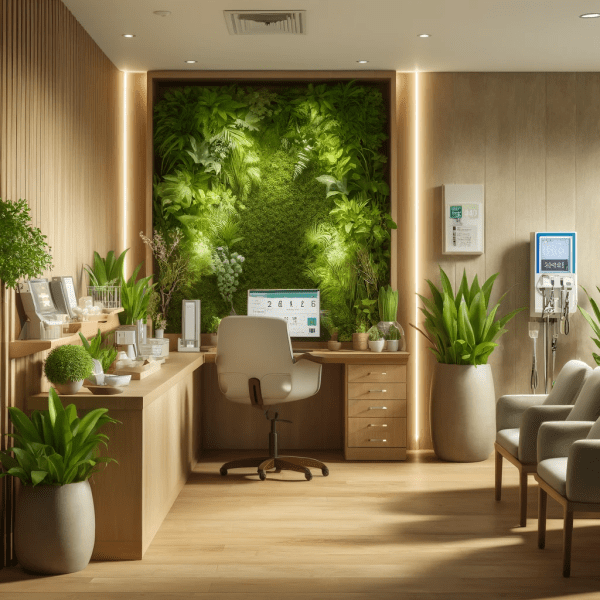Biophilic design is an approach to architecture and interior design that focuses on connecting people with nature in the built environment. The term “biophilic” comes from “bio,” meaning life, and “philia,” meaning affinity or love. So, biophilic design aims to satisfy our innate human need to affiliate with nature and other forms of life.
The benefits and impacts of biophilic design have been well documented through scientific research. Studies show that biophilic spaces can:

Biophilic elements in medical clinic interior design also increase patient satisfaction and comfort during their visit. The natural aesthetics create a warm, welcoming environment that feels uplifting. This helps put patients at ease and makes the experience of visiting a clinic less stressful and more positive. Additionally, the biophilic design improves mood, lowers blood pressure, and enhances overall wellbeing wellbeing—all of which support the healing process.
For staff, biophilic spaces have been found to reduce fatigue and burnout while boosting focus and productivity. Working in environments with natural light, airflow, plants, and views of nature is more engaging and energizing compared to sterile, artificial spaces. The organic design and materials create a healthier, more inspiring workplace. This leads to improved job satisfaction and performance.
Biophilic design incorporates elements found in nature into the built environment. Several key strategies and elements can be incorporated into a medical clinic:
Natural Light
Letting in ample natural light is a core biophilic design principle. Studies show that exposure to daylight improves health outcomes and quickens recovery times. Large windows, skylights, and solar tubes allow natural light to flood interior spaces—position workstations and patient areas near windows to maximize light exposure.
Plants and Greenery
Incorporating live plants and greenery helps connect people to nature. Plants can be displayed in waiting areas, exam rooms, and offices. Hanging plants, green walls, and potted plants are easy options. Place plants in locations with sufficient natural light and consider air purifying varieties.
Natural Materials
Biophilic design utilizes reclaimed wood, stone, bamboo and other natural construction materials. These materials add warmth and texture while reducing environmental impact. Wood accents, stone floors or slate wall tiles can be incorporated into a clinic’s design.
Nature Views and Connections
Providing views of outdoor nature scenes reduces stress. Place seating areas next to large windows overlooking gardens, green spaces or natural landscapes. Outdoor walking paths and healing gardens allow for direct access to nature.
Natural Shapes and Forms
Incorporate organic, non-uniform shapes and forms inspired by nature. Curved walls, arched doorways, oval windows and circular seating areas reflect the diversity found in the natural world. Free-flowing, asymmetrical designs feel more organic than rectangular spaces with hard edges.
Water Features
The presence of water has a calming, restorative effect. Small indoor fountains or water walls add peaceful sounds to waiting rooms and lobbies. Outdoor fountains, ponds and streams can also be incorporated into landscape design. The reflective and kinetic nature of flowing water engages the senses.

Natural light and views of nature have been shown to reduce stress, improve mood, and speed up healing times. As such, incorporating natural light and views should be a top priority when designing a biophilic medical clinic. There are several effective strategies to achieve this:
Incorporating greenery is one of the most effective biophilic design strategies for a medical clinic. Studies show that being around live plants reduces stress, lowers heart rate and blood pressure, and improves overall wellbeing. There are several options for seamlessly integrating indoor greenery:

Choosing Earthy, Natural Colors
When selecting colors for your medical clinic, look to nature for inspiration. Earthy, natural color palettes have been shown to have a calming effect and promote wellbeing. Focus on neutral tones like greens, blues, browns, and beiges.
Final Thoughts
Biophilic design offers numerous benefits for medical clinics looking to create a more calming, healing environment. By thoughtfully incorporating elements from nature, clinics can help reduce patient stress and anxiety while also boosting staff wellbeing.
When implementing biophilic strategies, start by identifying high-impact areas to focus on first. For example, introduce more natural light and greenery into waiting areas. Also, use natural materials and earthy colors in exam rooms to evoke a warm, organic feel.
With careful planning and execution, biophilic medical clinic interior design can provide a tranquil oasis for improving health and wellness. The investment pays dividends through reduced stress, increased satisfaction, and faster healing. The thoughtful biophilic design allows clinics to deliver not just quality medical care but an overall atmosphere of holistic healing.
If you’re seeking professional interior design services for medical facilities, like those offered by Murshid Interiors, it’s essential to ensure you choose a team with experience and expertise in healthcare design. Medical interior design requires careful consideration of functionality, infection control, patient comfort, and compliance with regulations.
Related Posts
INFORMATION
Copyright © 2024 Murshid Interiors All rights reserved